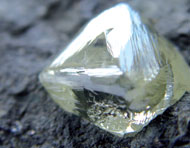A precious job.
Gentle grinding by means of a POLYCOM® high-pressure grinding roll.
Diamonds are the hardest natural mineral. Compared with the second hardest mineral, corundum, which can be used for grinding high-alloyed steels, the abrasive hardness of diamonds is 140 times higher. Hence diamonds can only be machined by diamonds. To do so, diamond crystals with different degrees of hardness are used.
Diamond Fever
Every year approximately 25 to 30 tonnes of the precious raw material are extracted from mines all over the world. The largest deposits are situated in Russia, Australia, Canada and in the south of Africa. Every so often, new deposits are found, although the search for deposits that are worth working has become increasingly difficult and more cost-intensive. Estimates are that the exploration costs of the entire sector amounted to about 800 million US$ in 2007. That is roughly three times as much as the costs incurred in 2002.
|
|
A raw diamond – the objective of all efforts. |
Nevertheless only about one fifth of the worldwide demand can be met with natural diamonds. Therefore industry has been using synthetically produced diamonds, which are less expensive, for a number of years now.
However, natural diamonds are still preferred when it comes to exclusive jewellery or inflation-proof investments. The worldwide economic growth has created an increased demand for the precious mineral, especially in China and India, which are experiencing an economic boom. Nevertheless, the largest buyer of diamond jewellery is still the USA, accounting for almost 50 % of the purchases.
Most deposits consist of diamonds that some 70 to 150 million years ago were ejected by eruptions onto the surface of the earth with kimberlite, a volcanic material. Hence they must first be extracted from the matrix without being damaged.
In most diamond mines, this complex process is nowadays handled by high-pressure grinding rolls, and in many cases these are POLYCOM@ plants. The ore-breaking process enables the careful extraction of diamonds up to a diameter of 25 mm, which equals to a gross weight of 150 carat. The POLYCOM@ grinding rolls moreover produce a very high proportion of fines, thus facilitating the processes in the downstream plant sections, so that operating and investment costs are significantly cut down.
In August and in December, further POLYCOM@ grinding rolls went into operation in Canada, at diamond mines in Snap Lake and in Ontario.
The POLYCOM@ is not only perfectly suitable for breaking diamond ore, but it has also been a huge success when it comes to processing other minerals.




